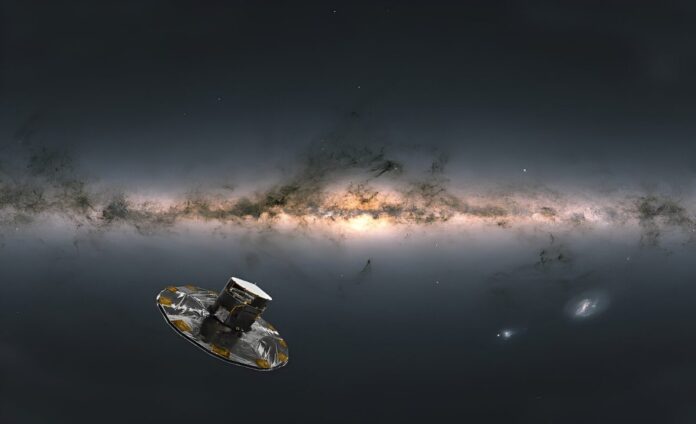Ripples in a pond can be captivating on a nice sunny day as can ripples in the very fabric of space, although the latter are a little harder to observe. Using the highly tuned Gaia probe, a team of astronomers proposes in a paper posted to arXiv preprint server that it might just be possible to detect gravitational waves through the disturbance they impart on the movement of asteroids in our solar system.
Gravitational waves are difficult to observe, largely because they are invisible and incredibly fast, traveling at the speed of light (approximately 300,000 km per second). Despite the challenge in observing them, the first waves were detected in 2015 using the Laser Interferometer Gravitational-Wave Observatory, or LIGO for short.
Let’s go back a little first though. It was Einstein who first suggested that an event in the universe that exhibited movement; perhaps two objects orbiting each other or a star exploding might generate ripples through space, stretching and squeezing anything in its path. These are the gravitational waves and that’s what LIGO detected eight years ago, supporting Einstein’s theory.
Current observations of gravitational waves are limited to those in the 100 Hz frequency which are produced during the merger of compact binary stars. Another technique uses Pulsar Timing Arrays (PTAs) to explore wave frequencies between 10 to 8 Hz.
The PTA method examines a known selection of millisecond pulsars across the galaxy. Pulsars are the highly magnetized remains of a supermassive star that has gone supernova and emit beams of radiation out of their magnetic poles. As the pulsar rotates and if its poles are aligned with Earth, we see a regular burst or pulse of radiation as the beam sweeps by.
A pulsar’s pulse is highly precise and they make fabulous timekeepers across the universe. PTA’s observe these pulsars and constantly review the pulse timings. If a gravitational wave passes through, then tiny yet observable differences in the arrival of the pulse will occur showing up as differences in the time signature. Measuring pulsar timings is an accurate way of detecting gravitational waves but it looks like Gaia wants in on the act.
Gaia is capable of making highly accurate astrometric measurements of an object’s position. The team suggests that using Gaia, then the position of stars or other more nearby objects may reveal the passage of a gravitational wave.
The paper goes on to state that Gaia might even be able to detect gravitational waves based on the effect they have on asteroids in our solar system. It depends, on the wavelength of the gravitational waves which can range from the diameter of the Earth up to the distance between the sun and Pluto, maybe even longer. The researchers concentrated their study on waves of the order of 1 million astronomical units and concluded that they could indeed be revealed by the disturbance in the movement of asteroids.
Reference:
Giorgio Mentasti et al, Observing gravitational waves with solar system astrometry, arXiv (2023). DOI: 10.48550/arxiv.2311.03474
© Universe Today
